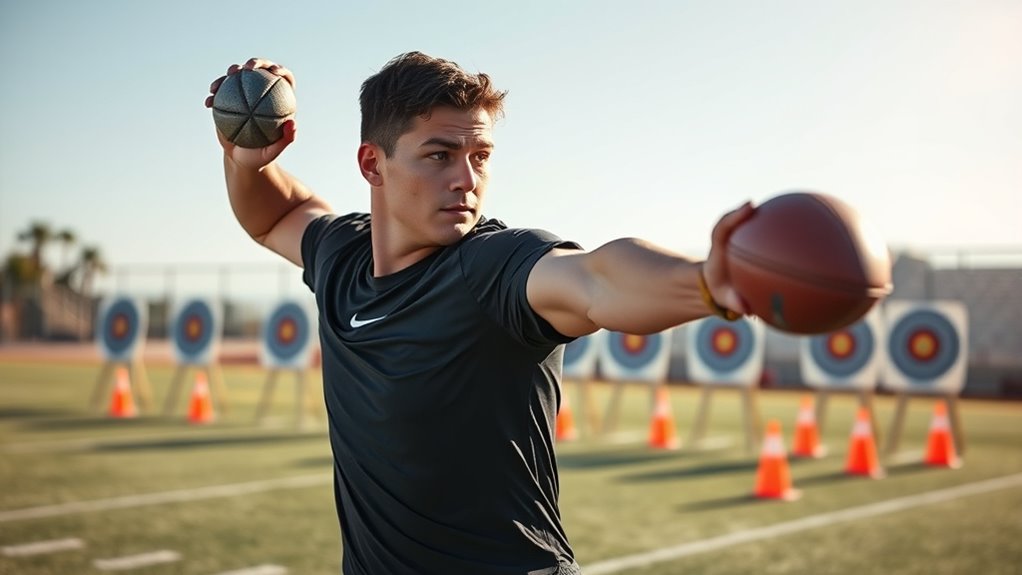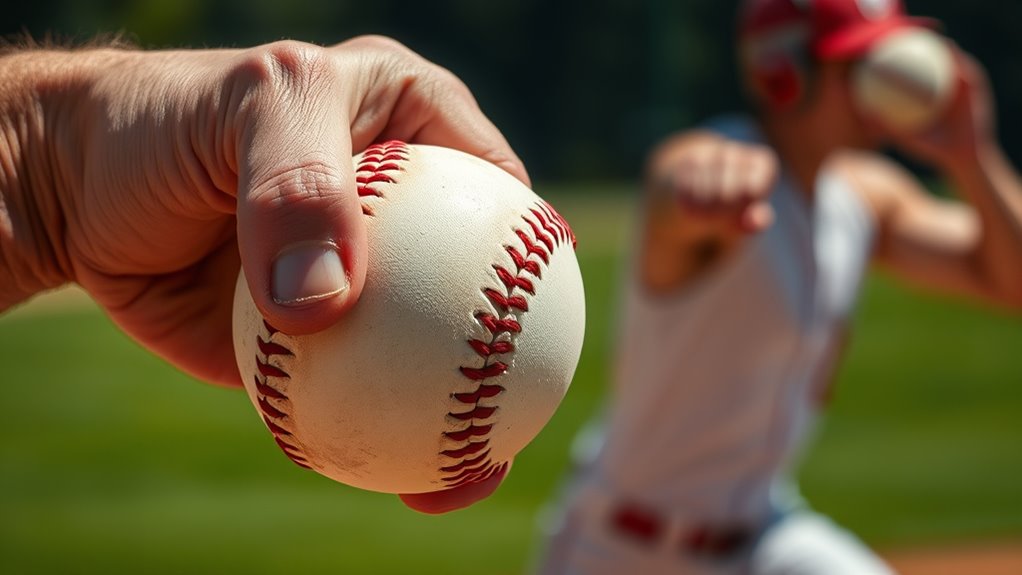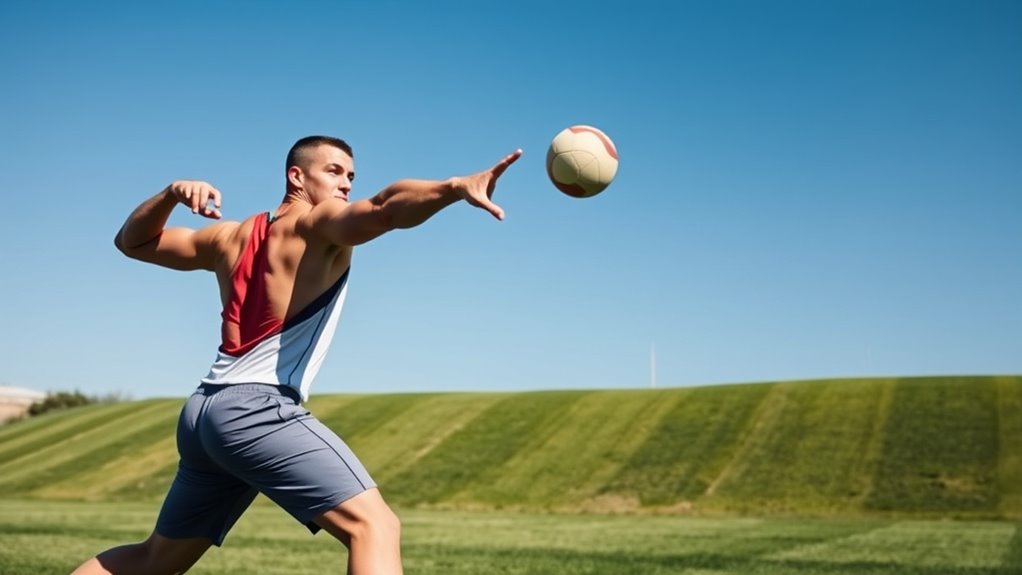To boost your throwing strength and accuracy, focus on mastering proper mechanics like grip, arm positioning, and using your legs for power. Build core and upper body strength with exercises such as planks, push-ups, and resistance drills. Practice targeted accuracy drills, improve grip control, and incorporate explosive plyometric movements. Consistent routines, monitoring your progress, and maintaining flexibility are essential. Keep refining your techniques, and you’ll discover even more ways to enhance your skills as you continue.
Key Takeaways
- Focus on proper throwing mechanics, including grip, arm positioning, and using legs and hips for power.
- Incorporate strength training for your core and upper body with exercises like planks, push-ups, and resistance band workouts.
- Practice targeted accuracy drills at various distances and angles to develop muscle memory and precision.
- Use explosive plyometric exercises and dynamic contrast training to enhance overall throwing power.
- Monitor progress through video analysis, set specific goals, and ensure thorough warm-ups to prevent injuries and improve consistency.
Understanding Proper Throwing Mechanics

To improve your throwing strength and accuracy, understanding proper throwing mechanics is essential. You need to focus on your grip strength, ensuring you hold the ball firmly but not too tight, which helps control your throw. Proper arm positioning is equally important; keep your elbow up and your arm at a 90-degree angle during the wind-up. When you throw, use your legs and hips to generate power, then transfer that energy through your arm. Avoid overextending or rushing your throw, as this can reduce accuracy and strain your muscles. Maintaining a consistent grip and proper arm positioning allows for better control and force transfer. Additionally, practicing vetted techniques can help you develop more consistent and effective throwing mechanics. Mastering these fundamentals sets a strong foundation for more advanced techniques and helps prevent injury.
Building Core and Upper Body Strength

Building core and upper body strength is essential for increasing your throwing power and accuracy. A strong core provides stability, allowing you to transfer energy efficiently from your lower body through your upper body during each throw. Focus on exercises that improve core stability, like planks, Russian twists, and leg raises, to enhance control and balance. Developing upper body endurance helps you maintain consistency and power over multiple throws, reducing fatigue and improving overall performance. Incorporate push-ups, shoulder presses, and rows into your routine to build strength and stamina. Remember, a solid foundation of core stability and upper body endurance translates directly into more precise, powerful throws. Proper size and dimensions of your training routine are crucial for optimal progress. Prioritize this foundation to see noticeable improvements in your throwing ability.
Incorporating Resistance Training Exercises

Incorporating resistance training exercises into your routine is a highly effective way to boost your throwing strength and accuracy. Resistance band training helps target specific muscles involved in throwing, improving stability and power. Weighted ball exercises add resistance that enhances muscle endurance and coordination. To get started:
- Use resistance bands for shoulder rotations to increase mobility and strength.
- Perform weighted ball throws to simulate actual throwing motions with added resistance.
- Incorporate resistance band chest presses to build pushing power.
- Practice overhead throws with a weighted ball to develop explosive strength.
- Be aware of potential side effects such as memory loss when using certain medications like gabapentin, and consult healthcare providers to weigh risks and benefits.
Practicing Targeted Accuracy Drills

Practicing targeted accuracy drills is essential for refining your throwing precision and consistency. Focus on specific drill design to challenge your ability to hit precise spots. Set up targets at varying distances and angles, then aim carefully to improve control. To maximize effectiveness, vary your drills to prevent plateaus and keep your skills sharp. Consider this approach: | Focus Area | Key Benefit | |—————–|———————————| | Varying distances | Builds adaptability and range | | Different angles | Enhances directional control | | Repetition | Reinforces muscle memory | Additionally, incorporating deliberate practice can accelerate your skill development by focusing on specific weaknesses.
Enhancing Grip and Hand Control

To improve your throwing strength and accuracy, focusing on enhancing your grip and hand control is essential. Developing grip strength and hand dexterity allows you to hold and release objects more precisely. Here are four ways to boost these skills:
- Practice squeezing a grip strengthener regularly to build power.
- Perform finger and hand stretches to improve dexterity and flexibility.
- Use small objects like stress balls or putty to enhance hand control.
- Incorporate isometric holds, gripping and holding for several seconds to increase endurance.
- Incorporate performance tuning techniques to optimize hand and grip performance for better control and precision.
Consistently working on these exercises will sharpen your grip strength and refine hand dexterity, giving you better control over your throws and improving overall accuracy.
Using Plyometric and Explosive Movements

Incorporating plyometric and explosive movements can markedly boost your throwing power. Explosive plyometric drills, vertical jump exercises, and medicine ball throws are excellent tools to develop rapid force. These exercises help you generate more power and improve your overall accuracy. Additionally, practicing self-reflection on your technique can help identify areas for further improvement and build confidence in your skills.
Explosive Plyometric Drills
Explosive plyometric drills are essential for developing quick, powerful movements that translate directly to increased throwing strength and accuracy. These drills enhance your ability to generate force rapidly, improving overall performance. To maximize benefits:
- Use a medicine ball to perform explosive throws, focusing on rapid, controlled movements to boost power and hand-eye coordination.
- Incorporate plyometric push-ups to develop upper-body explosive strength, translating to more forceful throws.
- Practice bounding exercises to increase leg power and explosiveness, aiding in stance stability and transfer of energy.
- Include medicine ball slams to improve core strength and coordination, vital for accurate, powerful throws.
- Understanding heat pump technology can inspire innovative approaches to training, such as integrating temperature regulation to optimize performance and recovery.
Consistently applying these explosive plyometric drills sharpens your reflexes and strength, elevating your throwing game.
Vertical Jump Enhancements
Building on your explosive plyometric drills, focusing on vertical jump enhancements can considerably boost your overall athletic power. Improving your vertical leap directly increases jump height, which translates into better performance in throwing and other explosive movements. To do this, incorporate exercises like box jumps, depth jumps, and bounding drills into your routine. These movements develop fast-twitch muscle fibers, enhance your explosive strength, and improve your ability to generate maximum force quickly. Focus on proper landing mechanics and explosive upward movement to maximize gains. Consistently training these plyometric and explosive movements will help you elevate your jump height, which in turn enhances your ability to generate power and accuracy in your throws. Incorporating training techniques that focus on rapid force development can further accelerate your progress. Stay dedicated, and you’ll see measurable improvements in your athletic performance.
Medicine Ball Power
Using a medicine ball effectively can substantially boost your throwing power by engaging your fast-twitch muscle fibers and emphasizing explosive movements. To maximize power training, focus on proper medicine ball technique during plyometric exercises. Here are key steps:
- Start with a controlled squat, holding the ball at chest level.
- Explode upward, throwing the ball forcefully against a wall or to a partner.
- Catch the rebound quickly and immediately repeat the movement.
- Maintain core stability and quick, explosive motions throughout each rep.
- Incorporate dynamic contrast training to further enhance your explosive strength and power output.
This sequence trains your muscles to generate maximum force rapidly, improving your overall throwing strength and accuracy. Incorporate these drills regularly to develop explosive power, making your throws more powerful and precise.
Developing Consistent Throwing Routines

Creating a consistent throwing routine starts with establishing a proper warm-up to prevent injuries and prepare your muscles. Then, set a regular practice schedule to build muscle memory and improve steadily. Remember to track your progress regularly so you can adjust your routine and stay motivated. Incorporating cultural exchange through poetry can also enhance your focus and emotional connection during practice sessions.
Establish Warm-Up Procedures
Have you established a warm-up routine that prepares your body for throwing? A solid warm-up boosts your performance and reduces injury risk. Start with these steps:
- Perform dynamic stretching to loosen muscles and improve range of motion.
- Incorporate light cardio to increase blood flow and elevate your heart rate.
- Focus on mental preparedness by visualizing throws and focusing your mind.
- Do some low-intensity throws to activate your muscles and refine your technique.
This routine helps you shift smoothly into your throwing session, ensuring both your body and mind are ready. Consistency in your warm-up creates a reliable foundation, allowing you to increase strength and accuracy over time. Remember, a well-prepared athlete is an effective athlete.
Set Regular Practice Schedule
Establishing a regular practice schedule is essential for developing consistent throwing routines and improving your accuracy and strength. When you set specific times for practice, you foster practice consistency, which accelerates progress. Consistent routines help reinforce muscle memory and build confidence. To maximize effectiveness, incorporate goal setting into your schedule, such as aiming for a certain number of throws or specific accuracy targets. Use this table to structure your sessions:
| Practice Focus | Duration | Goals |
|---|---|---|
| Warm-up & drills | 15 mins | Improve technique |
| Accuracy drills | 20 mins | Hit target consistently |
| Strength exercises | 10 mins | Increase power |
Following this plan helps you stay disciplined and focused, ensuring steady improvement.
Track Progress Consistently
Tracking your progress consistently helps you identify what’s working and where you need improvement. Focus on key areas like throwing biomechanics and grip strength to refine your routine. Here’s how to stay on track:
- Record your throwing biomechanics, noting mechanics and consistency.
- Measure grip strength regularly to guarantee your grip remains firm and controlled.
- Use video analysis to compare progress over time and spot flaws.
- Set specific goals based on your data to improve accuracy and power.
Tracking Progress and Adjusting Techniques

Monitoring your progress is essential to improving your throwing strength and accuracy, as it helps you identify what’s working and what needs adjustment. By tracking your progress regularly, you can see patterns and measure improvements over time. Use specific metrics, such as throw distance, accuracy scores, or consistency, to evaluate your performance objectively. When you notice a plateau or decline, it’s time to adjust techniques—whether that means refining your grip, stance, or follow-through. Staying attentive to your data allows you to make informed decisions and tailor your training. Remember, consistent tracking isn’t just about noting successes; it’s about understanding setbacks and making strategic adjustments to keep advancing your skills effectively.
Maintaining Flexibility and Preventing Injuries

As you focus on refining your technique and tracking your progress, maintaining your flexibility becomes increasingly important. Incorporate regular stretching routines to keep muscles loose and improve range of motion. This helps prevent injuries caused by tightness or overstretching. To optimize injury prevention, consider these steps:
- Warm up thoroughly before throwing sessions.
- Include dynamic stretches to activate muscles.
- Perform static stretches after workouts to improve flexibility.
- Listen to your body and avoid overstretching or pushing through pain.
Frequently Asked Questions
How Long Does It Typically Take to See Improvements in Throwing Strength?
You’ll usually notice improvements in throwing strength within 4 to 6 weeks, provided you stay consistent with your training. Regular strength exercises and dedicated practice help build muscle and enhance technique. Keep in mind, individual progress varies based on effort, technique, and fitness level. Stay committed to your training consistency, and you’ll see gradual gains that boost both your strength and accuracy over time.
Are There Specific Diets That Can Enhance Throwing Performance?
Picture your body as a finely tuned engine, needing the right fuel to perform at its best. Nutrition strategies like balanced diets rich in protein, healthy fats, and carbs boost your throwing performance. Supplement options such as creatine or omega-3s can also enhance strength and focus. Staying hydrated and eating smart guarantees your muscles recover quickly, helping you aim accurately and throw with power. Proper diet makes all the difference.
Can Mental Focus Techniques Improve Throwing Accuracy?
Mental focus techniques can considerably improve your throwing accuracy. By practicing visualization techniques, you mentally rehearse perfect throws, boosting confidence and precision. Incorporating breathing exercises helps you stay calm and focused under pressure, reducing nerves that can throw off your aim. When you consistently use these techniques, you train your mind to maintain concentration, leading to more accurate throws and better overall performance during games.
What Are Common Mistakes That Hinder Throwing Progress?
Like a car with misaligned wheels, your progress can stall if you ignore grip issues or skip proper warm-ups. Common mistakes include gripping the ball too tightly, which hampers fluid motion, and rushing into throws without warming up muscles. These errors reduce accuracy and strength. Focus on a relaxed grip and thorough warm-ups to improve your technique, ensuring steady, confident throws every time.
How Often Should I Rest Between Training Sessions?
You should prioritize proper rest intervals to optimize your training. Rest intervals of 24 to 48 hours between throwing sessions allow your muscles to recover and prevent injury. Depending on your training frequency, you might train 3 to 4 times a week, ensuring each session is effective without overtraining. Listening to your body is key; if you’re sore or fatigued, take extra rest days to enhance your progress.
Conclusion
By consistently applying these techniques, you’ll see your throwing strength and accuracy improve. For instance, imagine a beginner who practices targeted drills daily—within weeks, they hit their target more often and throw farther. Keep tracking your progress, adjust your routines, and stay flexible to prevent injuries. With dedication and the right approach, you’ll become a more powerful, precise thrower, turning your goals into real achievements on the field or court.









